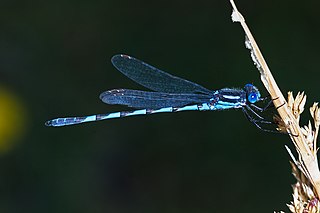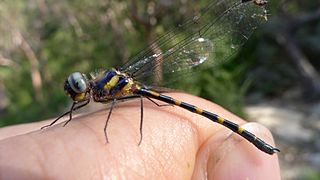
The Platycnemididae are a family of damselflies. They are known commonly as white-legged damselflies. There are over 400 species native to the Old World. The family is divided into several subfamilies.

Aciagrion is a genus of damselfly in the family Coenagrionidae. Aciagrion are small and slender damselflies with a small head. They are found at still waters including swamps. Aciagrion is widely distributed in the tropics from Africa, through Indonesia to Australia. They are commonly known as Slims.

Agriocnemis is a genus of damselfly in the family Coenagrionidae. Agriocnemis is distributed widely across Africa, South-east Asia, Indonesia, Australia and islands in the Pacific. They are small insects, commonly known as wisps.

Argiocnemis is a genus of damselfly in the family Coenagrionidae. Species of Argiocnemis are generally small to medium-sized damselflies, darkly coloured with pale markings. They occur in Africa, Indian Ocean islands, South-east Asia, New Guinea and Australia.

Ceriagrion is a genus of damselfly in the family Coenagrionidae. Species of Ceriagrion are small to medium size, generally brightly coloured damselflies. They are found across the Old World, Africa, Asia and Australia.

Hemiphlebia mirabilis, commonly known as the ancient greenling, is a species of damselfly, the only living species of the genus Hemiphlebia and the family Hemiphlebiidae. It is very small with a long, metallic-green body and clear wings. It is endemic to south-eastern Australia. Its natural swamp habitat is threatened by habitat loss. The oldest representatives of the family date to the Late Jurassic.

Argiolestinae is a subfamily of damselflies. They belong to the flatwing damselfly family, Argiolestidae. Like their relatives but unlike damselflies of other families, they usually spread their hindwings horizontally when resting. It is the largest subfamily in Argiolestidae, making up almost three-quarters of the family's species, found primarily in Australia, New Guinea, and New Caledonia.

The Lestoideidae are a family of damselflies occurring in South-east Asia, New Guinea and Australia. The family comprises two genera and nine species.

Austrolestes is a genus of medium to large-sized damselflies in the family Lestidae. Austrolestes damselflies sit with their wings folded completely back. Males are usually bright blue and black, the females duller. Members of this genus are found in Australia, New Zealand and South Pacific islands.

Diphlebiidae is no longer recognised as a biological family. It was the name given to a small family of damselflies, the azure damselflies, with species in two genera: Diphlebia and Philoganga. Diphlebia is found in Australia and Philoganga is found in Southeast Asia. They are large and thick-bodied damselflies. They rest with their wings spread out. The Diphlebiidae were also known as Philogangidae.

Diphlebia is a genus of damselflies in the family Lestoideidae. They are commonly known as rockmasters. These damselflies are very large and thick. The species in this genus are found in Eastern Australia, except for one species that can be found in New Guinea. The males are vividly patterned. They are blue or bluish green and black in colour. Their blue colour also gives them the name azure damselflies. They rest with their wings spread out. Their wings are usually blackish brown or have white markings. These damselflies have several present antenodal crossveins. The two basal crossveins extend across costal and subcostal spaces. The larvae are wide and flat. They have long saccoid gills enabling them to breathe underwater. The inner tooth of their labial palps is elongated. The specific characters of the larvae are mid-ventral, distal width, basal width, and length of median lobe.

Austroargiolestes is a genus of damselflies in the family Argiolestidae. They are commonly known as Flatwings; unlike many other damselflies, at rest their wings are spread out flat.

Neurobasis is a genus of damselflies belonging to the family Calopterygidae. They are found from India, through south-east Asia, Indonesia and New Guinea.

Lestoidea is a genus of damselflies in the family Lestoideidae, commonly known as bluestreaks. Its species are endemic to north-east Queensland, Australia, where they inhabit rainforest streams.

Cordulephya is a genus of dragonflies in the family Cordulephyidae, endemic to eastern Australia. The species are small to tiny in size, coloured black, or purplish-black, with yellowish markings. Unusually for Anisoptera, these dragonflies rest with their wings folded above their body in a similar manner to many species of damselfly. They are commonly known as shutwings.

Austroagrion is a genus of damselflies belonging to the family Coenagrionidae. Species of Austroagrion are small damselflies; males are black with blue or green markings while females are paler. Austroagrion occurs in Papua New Guinea, New Caledonia and Australia.

Synlestes is a genus of damselflies in the family Synlestidae. Species of Synlestes are very large damselflies, metallic green to dark bronze or black in colour with white, yellow or orange markings. Unlike many other damselflies, they spread their wings when resting. They are endemic to eastern Australia where they inhabit streams.

Podopteryx selysi is a species of Australian damselfly in the family Argiolestidae, commonly known as a treehole flatwing. It can be found in coastal northern Australia and New Guinea, where its larvae live in water-filled holes in tree trunks in rainforest.
Podopteryx casuarina is a species of flat-wing damselfly in the family Argiolestidae.

Argiolestidae is a family of flat-wing damselflies in the order Odonata. There are at least 20 genera and more than 160 described species in Argiolestidae.


















